K7XX (Drop)
back to AKG
back to measurements
home
Published: Jan-12-2019, updated: Aug-8-2020
NO SMOOTHING is applied to the shown plots. Most measurement sites have some smoothing applied which ‘irons flat’ sharp peaks and ‘wiggles’. I do not use smoothing because some info about sound quality is lost when plots are smoothed.
Aside from a small correction of the microphone itself also some correction in the lowest frequencies is applied to the plots to compensate for the perceived loss of bass when using headphones. This is described HERE in more detail.
A ‘horizontal‘ frequency response curve on the shown frequency response plots on this website thus indicates a perceived ‘flat’ tonal signature.
ALL measurements are made with a good SEAL on a flatbed measurement rig.
The shape of your head, bone structure, pad size, pad ‘softness, (compliance), hair or no hair and or wearing glasses may (drastically) change the frequency response of some headphones, so… your personal experience may differ substantially from these plots.
Frequency response (tonal balance) is the most sound-determining aspect of headphones. A horizontal line shows audible neutral response in the plots on this website. Deviations in different severities at different frequency bands have an effect on the sound character.
The bigger the deviation the stronger the effect.
Below an aid to help determining the sound character of headphones with relation to the frequency response.


AKG K7XX Red
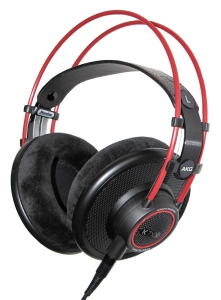
The AKG K7XX (red) is a Drop only product. The red accents look very nice to me but is a personal taste. The leather headband has red stitching on it as well.
The headband can adjust over a wide range but isn’t padded. It does not push hard on my head but one does feel a small contact point and the cups have a small tendency to drop a little lower in my case.
L and R markings are easy to see and in a logical place. A give away for the left cup is the cable entry as well. Some headphones have cable entries on the right. Most single entry headphones have it on the left.
The cable is thin and long (3m) and just mildly microphonic. It terminates in a 3-pin mini XLR which means no balanced drive is possible. A 4 pin mini-XLR would have been more ‘universal’ so balanced amps could also be used. The cable terminates in a 3 pin TRS jack with a 6.3mm screw-on adapter.
The fact that it has a long cable suggests it is not intended for portable usage. As the K7XX is not a high efficiency headphone this too suggests it is not designed for portable usage. Add to that the K7XX is an open headphone and that it does not play sufficiently loud from phones/tablets and cheap DAPs makes it obvious this headphone is only really suited for home and studio usage.
The pads are large in diameter (60mm) and have a nice depth (22mm) so most ears will fit. The pads are velour and have memory foam inside. This creates a good seal and a pleasant fit despite the clamping force being somewhat higher than ‘neutral’. It does make sure the headphone stays put and doesn’t move around when moving around.
This headphone is quite comfortable and can be worn for long periods without getting too ‘hot’ on the ears. The headphone is light in weight.
The efficiency is not high but also not problematically low nor ‘hard to drive’. It does require a bit more voltage than most low impedance headphones. 62Ω is a pleasant value for headphone amps. Most amps (unless OTL tube amps) won’t have any trouble driving this headphone.
specifications:
Type: On-ear, open
Usage: Home, Studio
Isolation: low (open headphone)
Driver type: dynamic
Pads: replaceable, memory foam with velour cloth
Pad dimensions: Ø 60mm , depth: 22mm
Collapsible: no
Headphone connector: 3-pin mini XLR
Cable entry: left sided.
Cable: 3m terminated in 3.5mm TRS + screw-on 6.35mm adapter
Driver size: ø 40mm
Nom. power rating: 0.2W (200mW)
Max. voltage: 3.5V
Max. current: 56mA
Max. S.P.L.: 116dB
Impedance: 62Ω
Efficiency: 90dB @ 1mW
Sensitivity: 102dB @ 1V
Weight: 235 g.
Colour: black with red accents
Clamping force: medium
Accessories: 6.3mm screw-on adapter
Sound description:
The AKG K7XX (red) has a ‘warm neutral-ish’ tonal balance.
Bass is extended enough. Not overblown bit also not bass-light like the K701/K702. Bass is not flabby and fairly well defined. Bass to mids transition is very good.
The mids are on the warm side of things. The typical 2kHz bump (which makes the K701 overly ‘forward’ is not present here. The mids sound ‘open’ and reasonably dynamic but do lack some clarity/presence compared to the HD650 for instance.
It does not sound rolled off nor very ‘scooped’ in the mids.
Those that dislike ‘sharpish defined’ mids may prefer the K7XX. The mids could be called laid-back as in the opposite of very forward/clear/bright.
The treble isn’t as overblown as say the K612 and K701. It also isn’t lacking treble. The treble is on a proper level, certainly compared to other AKG’s from this line-up. The treble is not ‘soft/smooth’ but is somewhat ‘coarse’ and not very ‘refined’.
The fact that the K7XX is not sibilant nor sounds ‘distorted’ or sharp still makes the overall sound quality quite decent, really only lacking in presence/clarity a bit and ‘finesse/smoothness’.
measurements:
Below the frequency response of the K7XX (Left, Right)
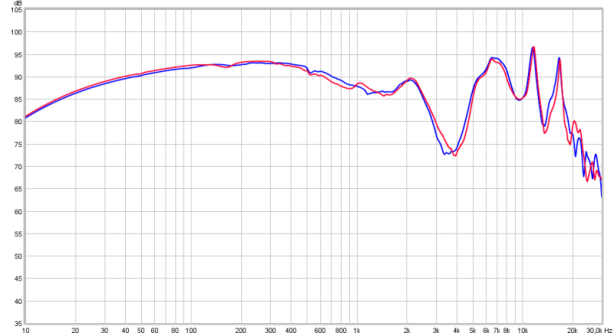 Channel matching is excellent. Bass extension is good. The small upwards slope from 20Hz to 200Hz makes bass sound ‘tight’ but certainly not ‘lean’.
Channel matching is excellent. Bass extension is good. The small upwards slope from 20Hz to 200Hz makes bass sound ‘tight’ but certainly not ‘lean’.
The mids from 200Hz to 2kHz are sloping downwards making the tonal balance of voices and instruments on the warmer side of neutral.
The -15dB depression around 3.5kHz is not that deep and is mostly ‘filled in’ by the Concha of the ear. I recommend not to EQ it in or just about 5dB or so.
The treble response is a bit ‘jagged’ and has a typical ‘AKG signature’. The jagged response above 6kHz makes the treble a bit coarse. Above 18kHz the response drops off quickly but still shows response at least up to 30kHz.
Below the K7XX vs the K612.
The K612 (better extended K601) is considered ‘neutral’ with a forward sound and sharpish treble it is obvious that the K612 is more ‘forward’ sounding which is shown by the tilt around 2kHz and much less deep 3.5kHz dip. Compared to the K612 the K7XX indeed has about 3dB more lows (as mentioned on the box) and is fuller/warmer and bassier sounding.
As most people tend to compare sounds to lower mids/bass below the exact same plot but ‘acoustically’ more comparable. The ‘sharper’ sound of the K612 compared to the K7XX is evident. Which sound signature one prefers is rather personal so one is not ‘better’ than the other, just different in tonal balance. K612 bright and clear, K7XX warmer and less bright.
seal
As the seal of this headphone is of importance some experiments showing the effect.
(lots of) hair between the headphone and ear or an ear shape that does not allow a proper seal will affect the tonal balance.
Below: Perfect seal, a small seal breach by thin armed (reading) glasses just above the skin, thick armed glasses and a big seal breach.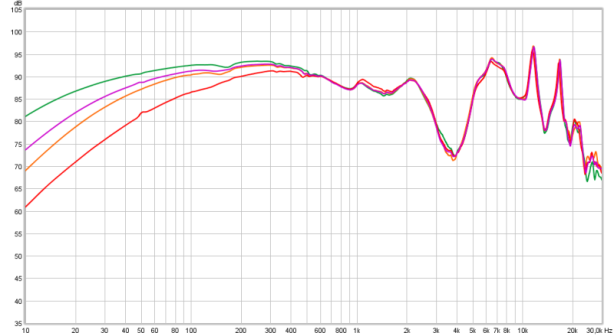 A small seal breach isn’t really problematic. The tonal balance is hardly affected by this.
A small seal breach isn’t really problematic. The tonal balance is hardly affected by this.
output resistance / damping-factor
As this is a dynamic headphone the frequency response might be amplifier output resistance dependent when certain higher output resistance amplifiers are used.
To test this the headphone is measured via a low impedance amplifier (0.2Ω) and a high impedance amplifier (120Ω).
On a higher output resistance amplifier the output level will be considerably lower. To compensate for this the amplifier is cranked up to the same level (9.5dB at 1kHz) as the low impedance amplifier. This way the plots are overlaid and it is easier to show the tonal balance differences.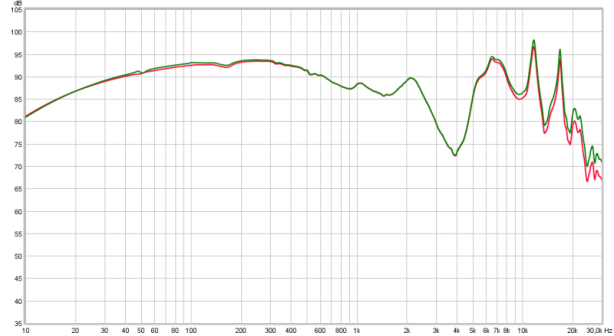 The headphone does not react to higher output resistances other than in level. There is hardly any difference. Upper treble is 1dB higher in level though. Bass hardly reacts.
The headphone does not react to higher output resistances other than in level. There is hardly any difference. Upper treble is 1dB higher in level though. Bass hardly reacts.
The output resistance of the used source/amplifier has NO practical influence on the sound.
other measurements
Below the distortion measurements of the K7XX (Right channel) Below the same distortion plot but with the vertical scale in percentages instead of level differences.
Below the same distortion plot but with the vertical scale in percentages instead of level differences. 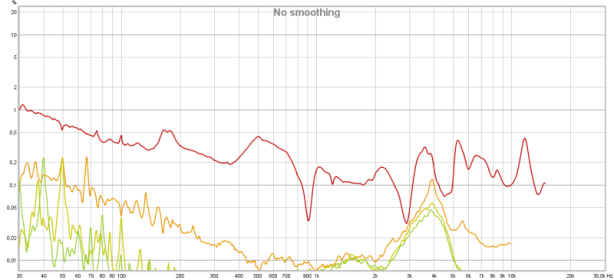 The 3rd harmonic and higher harmonics distortion is below 0.2% in the bass area which is quite good. The 2nd harmonic distortion remains well below 1% in the bass which is quite good. Above 100Hz the distortion stays below 0.5%.
The 3rd harmonic and higher harmonics distortion is below 0.2% in the bass area which is quite good. The 2nd harmonic distortion remains well below 1% in the bass which is quite good. Above 100Hz the distortion stays below 0.5%.
The 2nd harmonic distortion is probably lower than 0.2% around 1kHz as limits of the test rig are around that level.
Below the CSD of the K7XX. (Left and Right are superimposed)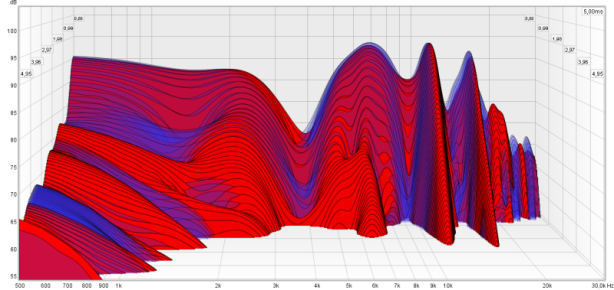 The dip around 4kHz is not a resonance in disguise. As mentioned above this dip is almost entirely compensated in level by the Concha of the ear. The narrow treble peaks are clearly resonances. This also points toward less refined treble.
The dip around 4kHz is not a resonance in disguise. As mentioned above this dip is almost entirely compensated in level by the Concha of the ear. The narrow treble peaks are clearly resonances. This also points toward less refined treble.
Below the spectrum plot of the K7XX (Right channel). 
This plot looks quite nice. The lower frequencies are quite well damped and ‘stop’ fast.
Around 2kHz there is a little lingering but very low in level and short lived. Don’t think this is detrimental to the sound. Between 10kHz and 20kHz the two resonances are visible but are also short.
The step response plot below (Left, Right)
This plot shows the impulse response/clarity is lacking somewhat. The sound signature is lower mids oriented with well extended but a bit sloping lows/sub lows.
Below the square-wave response of the K7XX. On the left 40Hz, in the middle a 440Hz square wave and on the right a 100μs wide DC impulse. The 40Hz squarewave looks pretty good. Bass extension is not great but still decent as the slope is gentle. The 440Hz squarewave shows the ‘laid back’ character of this headphone.
The 40Hz squarewave looks pretty good. Bass extension is not great but still decent as the slope is gentle. The 440Hz squarewave shows the ‘laid back’ character of this headphone.
The rising edge is a bit slow in following the stimulus. The 100μs pulse also is evidence of the laid back character as the target level is not reached compared to the lower mids.
The rising edge is fast enough but the level is too low (-7dB) compared to the mids. The ‘bounce’ after the first impulse is often seen with headphones having coarser treble. After that second pulse the membrane seems to be quite well damped.
foam ring
The AKG K7XX has a foam ring covering the driver. Of course this is there for a reason. On the left the K7XX driver with the foam removed, on the right the stock K7XX driver with the foam in front of it. The foam is just lying on the driver and pressed onto the driver using netting integrated in the pads. These pads are really easy to remove. Just rotate a few degrees counter-clockwise.


Below the frequency response measured with and without the foam.
Note the plots below are all smoothed to show tonal differences a bit more clearly.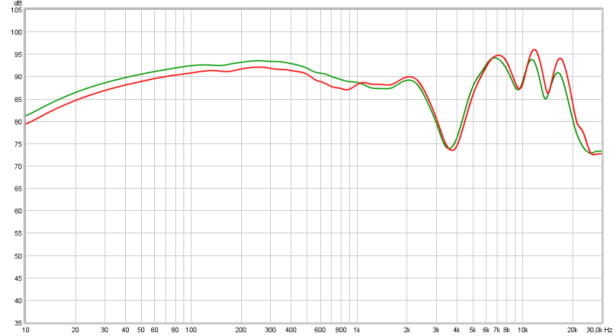
It is obvious the foam is there for a reason. The foam covers both the ‘ports’ around the driver and the outer part of the cone from the driver. The part over the dome remains open. The foam reduces the upper treble and at the same time increases the response below 1kHz. This seems to be a strange thing but the ‘ports’ feed back the frequencies below 1kHz. A small portion of the sound from the rear of the driver (which is in counter phase) thus lowers the sound from the front. Covering the ports completely will thus increase bass response even more. The ports are there to lower the output below 1kHz and not to increase the bass. These ports also serve another purpose which has to do with how the headphone reacts when seal is breached.
Below the CSD of the K7XX with (stock) the foam rings and without the foam rings. The foam not only lowers the treble peaks/resonances but also shortens (damps) them.
The foam not only lowers the treble peaks/resonances but also shortens (damps) them.
Of course I was curious to see if other known damping materials would give different results. Below some experiments with rings made of felt instead of foam.
stock foam, 1mm thick felt ring, 3mm thick felt ring.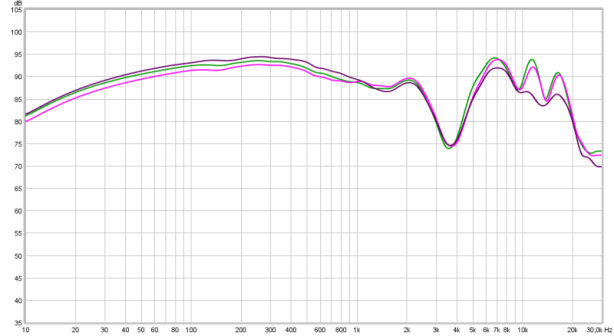 The 1mm felt ring is doing a less ‘job’ in covering the ports around the driver. The 3mm felt ring is more effective of course and thus increase the lower frequencies more.
The 1mm felt ring is doing a less ‘job’ in covering the ports around the driver. The 3mm felt ring is more effective of course and thus increase the lower frequencies more.
The 1mm felt lowes the treble in a similar amount. replacing the foam with 1mm thick felt (from crafts stores) thus makes the K7XX a very tiny bit (-1dB) more neutral. The 3mm felt makes the headphone darker as lower frequencies are higher (+1dB) and lowers the treble quite a few dB.
The 1mm thick felt is a good replacement it seems.
Below some experiments with rings made of soft 3 ply toilet paper where the plies are cut into rings and the 3 plies are pulled apart to form 3 very thin and fragile ‘rings’.
stock foam, 1 ply toilet paper ring, 2 plies toilet paper ring. The toilet paper (one or 2 plies does not really matter) does almost nothing for the ‘ports’
The toilet paper (one or 2 plies does not really matter) does almost nothing for the ‘ports’
Thus the tonal balance is just slightly (-1dB) less ‘warm’. Slightly closer to neutral.
1 ply of toilet paper damps the treble about the same amount as the foam. 2 plies reduces the upper treble too much and ‘muffles’ the upper treble/air.
Instead of using toilet paper rings one can also apply toilet paper discs thus covering the whole driver assembly. stock foam, 1 ply toilet paper disc, 2 plies toilet paper discs.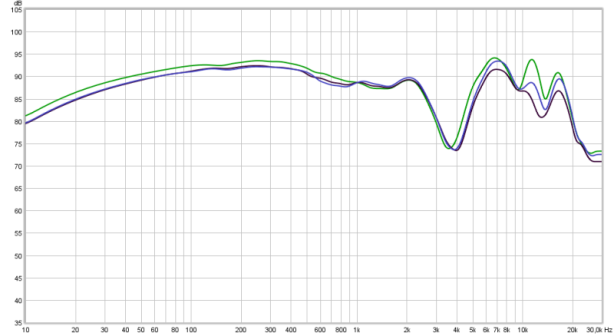 Here too the toilet paper (one or 2 plies does not really matter) does almost nothing for the ‘ports’. Thus the tonal balance is just slightly (-1dB) less ‘warm’. Slightly closer to neutral.
Here too the toilet paper (one or 2 plies does not really matter) does almost nothing for the ‘ports’. Thus the tonal balance is just slightly (-1dB) less ‘warm’. Slightly closer to neutral.
Above 1kHz the dip moves in frequency (due to more damping of the driver membrane) but the overall treble level is reduced more. The 2 plies version removes way too much treble and ‘dulls’ the sound.
Is the K7XX based on the K702 with a pair of K712 pads or just a cleaper version of the K712 ? Let’s try to find out.
Below the K702 vs the K702 with K712 pads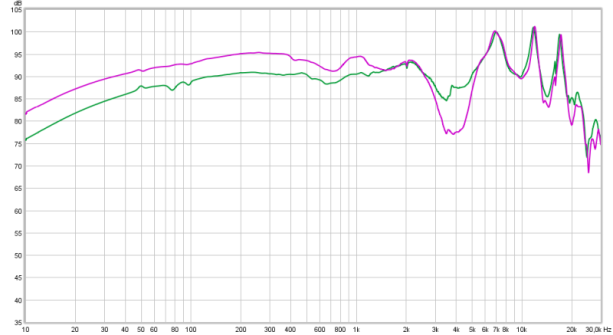 The K702 fitted with K712 pads makes the K702 a lot more balanced. You gain about 5dB in efficiency as well.
The K702 fitted with K712 pads makes the K702 a lot more balanced. You gain about 5dB in efficiency as well.
Below the K702 fitted with K712 pads compared to the K7XX
The K7XX has a bit more bass/lows compared to the K702 (with K712 pads). Above 1khz the reponse is pretty much the same. There is an audible (3dB) difference below 1kHz.
So it would appear these do not have the exact same drivers in there. The K702 driver may be damped a bit more.
Below the K7XX compared to the K712
Here too the drivers do not seem to be exactly the same. Above 2kHz everything seems quite similar. The biggest differences are in bass extension, where the K712 seems to have a bit more damping, and around 1.5kHz. There is a 4dB difference there which is audible. The K712 has a bit less ‘presence’ or ‘forwardness’ and is a bit ‘smoother’ sounding. There are differences here too so the driver of the K7XX is not the same as that of the K712 either.
Below the 3 headphones combined in one plot. K702 with K712(K7XX) pads, The K7XX and the K712. The K7XX has a bit more bass/lows compared to the K702 (with K712 pads) as well as the K712. The K712 is a bit less ‘forward’ (thus more ‘laidback’) compared to the other 2 which have a bit more clarity/presence.
The K7XX has a bit more bass/lows compared to the K702 (with K712 pads) as well as the K712. The K712 is a bit less ‘forward’ (thus more ‘laidback’) compared to the other 2 which have a bit more clarity/presence.
So it seems the K7XX driver differs from both the K702 with K712 pads and the K712 as well. I will chalk it up to different tuning of the driver and perhaps small changes in the driver membrane.
Also one can tame the 6kHz peak with a passive filter. This lowers the 6kHz peak just enough so it does not stand out any more yet still sounds detailed enough. The higher peaks are unattenuated but are not detrimental nor ‘sharp’. stock, filtered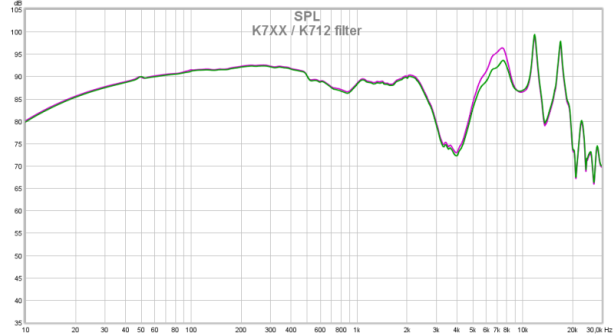
summary
The AKG K7XX is a decent sounding headphone with very good comfort. It will fit most heads. In price it sits right between the street price of the K702 and the K712.
When you own a K702 and would like it closer to the K7XX and K712 you can consider buying K712 pads. Unfortunately these are kind of expensive ($ 100.- for a pair !)
K702 pads are about $45.- a pair.
The K7XX has a a good bass response that doesn’t sound rolled-off like many other K7** models. (excluding the K712 I reckon). Not suited for bass-heads.
Treble and upper mids are much better in balance than most other K7** models.
The sound is warm and full with tight and not emphasized nor colored bass.
Mids are on a tad on the ‘laid back’ side of things but not as much as the K712.
Treble quality is not on par with that of the bass and mids, the K712 is slightly better in this department and sounds a bit ‘smoother’.
The K7XX is a bit coarse/grainy as in not ‘smooth, silky’ like TOTL headphones often show.
Those that find the HD58X, HD650 etc. too ‘forward’ may find the K7XX a nicer sounding option… but with less refined treble.
The treble amount is good though so no harsh or shrill mids anywhere.
Not suited to be driven directly from phones, tablets. It may not play impressively/loud enough.
Higher end DAPs (with a higher output voltage) and desktop gear is what’s required for this headphone.